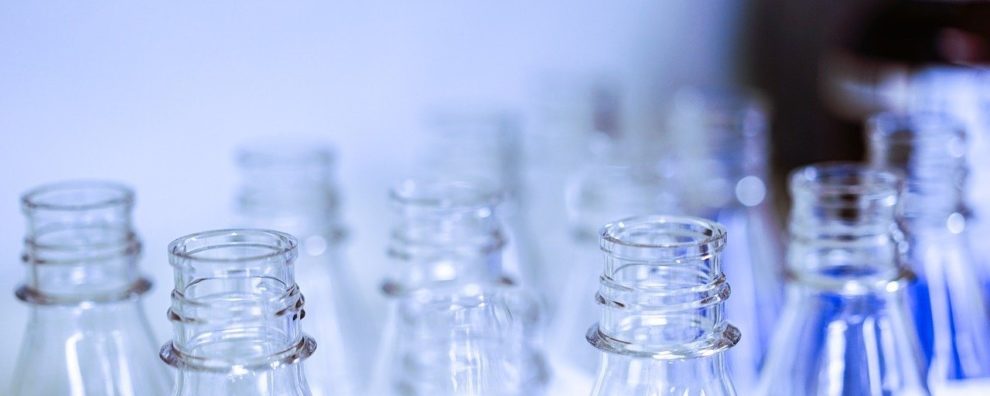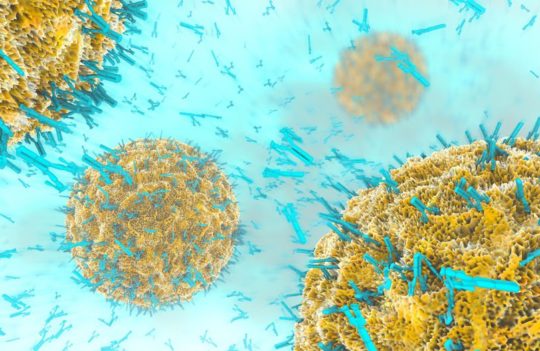 Antibody production
Antibody production
Fundamental and advanced methods to improve monoclonal antibody production in vitro
Ever since the discovery of the hybridoma technology and its inherent limitations, monoclonal antibody production has gradually shifted from hybridoma-based in vivo methods towards recombinant-based in vitro methods. Today, stable cell lines for monoclonal antibody production generated by recombinant processes, continue to be the gold standard for therapeutic applications. While hybridoma-based production, with a shorter turnaround but lower yield, continues to be sparsely used to produce antibodies for diagnostics and analytical applications.
- Preferred methods of monoclonal antibody production in vitro
- Fundamental steps to ensure high productivity in monoclonal antibody production in vitro
- Optimizing gene cloning, vector design, and transfection methods
- Using serum-free growth medium
- Rethinking bioreactor design
- Innovative tools to increase monoclonal antibody production in vitro
- Delaying apoptosis
- Arresting cell cycle progression
- Improving protein folding
- Modulating post-translational modifications
- Reducing waste accumulation by metabolic engineering
- Concluding remarks
- Discover ProteoGenix’s unique approach to monoclonal antibody production
Preferred methods of monoclonal antibody production in vitro
The preferred method of monoclonal antibody production is the in vitro recombinant-based technology. Among all possible recombinant expression systems, antibodies are typically produced in mammalian systems due to the inherent complexity of their post-translational modifications. In this context, Chinese hamster ovary (CHO) cells have become the industry’s workhorse when it comes to biopharmaceutical production.
Nevertheless, CHO cells still present some important limitations that have prompted the search for alternative systems or alternative methods for monoclonal antibody production in vitro.
In recent years, some researchers have pursued the use of microbial systems (bacteria and yeast) for antibody production. But these systems have often found limited applicability due to their inability to perform post-translational modifications and tendency to form inclusion bodies, which greatly hamper the final product yield. For this reason, microbial systems are usually reserved for early studies and antibody fragment production (VHH, scFv, among others).
However, the vast majority of antibodies approved for therapeutic use are full-length IgG-like molecules with complex glycosylation patterns. For these, stable expression in CHO is still the only system that can comply with production yield and quality standards.
Fundamental steps to ensure high productivity in monoclonal antibody production in vitro
Optimizing gene cloning, vector design, and transfection methods
For biopharmaceutical production, antibody genes are preferentially chemically synthesized (with sequence modifications/optimizations for mammalian cells expression); while for analytical purposes antibodies may still be cloned through conventional gene cloning methods. These conventional methods rely on the existence of a template and of adequate PCR amplification conditions. This imposes important limitations such as the risk of introducing errors during amplification or the impossibility to perform codon optimization.
On the contrary, gene synthesis technologies have become more cost-effective over the years and emerged as the best alternative to traditional gene cloning. Unlike traditional approaches, gene synthesis does not rely on a DNA template and involves the extension of the nucleotide chain in a stepwise manner. This approach allows a precise sequence design and optimization which ultimately results in higher expression levels and easier purification of the final product.
Other factors known to play a key role in the optimization of monoclonal antibody production in vitro are the choice and optimization of the expression vector, choice of an efficient selection system (e.g. glutamine synthetase (GS) metabolic selection), and optimization of transfection conditions.
But the same vector, selection system, and transfection conditions can lead to robust expression levels in some hosts and weak and inconsistent expression levels in others. For this reason, a deep knowledge of a host’s genetics is crucial for the success of any monoclonal antibody production project.
The large-scale production of therapeutic antibodies poses an additional set of challenges. Because these molecules contain complex glycans coating the Fc domains, the expression in mammalian systems is preferred. However, mammalian cells used in biopharmaceutical production lack natural self-replicating accessory genes (i.e. genes). For this reason, to achieve consistent and high expression levels, the antibody-encoding genes need to be integrated into the genome.
This integration is crucial for the stable expression of antibodies and it can currently be achieved using two main approaches:
- Random integration – as the name implies, the random integration of accessory genes does not take into account the genomic organization of a host. Thus, more often than not, these genes can be integrated into low-expression regions. Furthermore, the success rate of this approach is limited, resulting in longer lead times and more labor-intensive processes since a large number of clones need to be carefully evaluated prior to large-scale production.
- Site-specific integration – this approach allows a more precise degree of control. Thus, despite requiring a profound knowledge of a host’s genomic architecture (identification of domains with low or high expression levels) the success rate of this approach is optimal in comparison to random integration, leading to shorter lead times and less laborious processes.
Using serum-free growth medium
Traditionally, CHO cells are best adapted to grow in a serum-based medium. However, serum is an undefined animal product that often leads to unpredictable yields and may contain pathogens that compromise the safety of the final product.
For this reason, growth conditions have been gradually shifting from the use of animal-derived serum towards serum-free media. But yields have often suffered as a result. However, with the advent of recombinant technology, it became possible to produce complex nutrients such as albumin, transferrin, and lactoferrin in vitro, thus abolishing the need to risk using serum-derived nutrients.
Rethinking bioreactor design
Bioproduction has greatly improved over the years. Traditional batch or fed-batch bioreactors typically run for limited periods (7-21 days) and batches need to be renewed once toxic waste accumulation starts hindering production.
In contrast, newer technologies based on perfusion processes have offered considerable improvement. Currently, there are two dominant perfusion-based technologies for monoclonal antibody production in vitro: spin-filter perfusion and alternating tangential flow (ATF) perfusion. They both work according to the same principle; they keep cells in culture by continuously feeding them with fresh media and removing spent media to prevent toxic waste accumulation.
Recent studies show that ATF perfusion bioreactors outperform conventional batch and fed-batch technologies and consistently lead to higher yields and lower production costs. Nevertheless, this technology is more complex than its traditional counterparts often hindering its adoption for large-scale applications.
Innovative tools to increase monoclonal antibody production in vitro
Early efforts in monoclonal antibody production in vitro have relied on cell engineering. Mammalian systems such as CHO, NS0, or HEK all underwent important engineering efforts in an attempt to make them more amenable to transfection, selection, and to growth in suspension. But only with the advent of gene-editing tools has further engineering of these cell lines became possible.
In the next decades, it is likely that advanced gene-editing tools (e.g. CRISPR-Cas, zinc finger nucleases, transcription activator-like effector nucleases, etc.) will forever change how we transfect these cells and engineer them for optimal growth and productivity.
The important processes that can be further regulated by these tools include:
Delaying apoptosis
Programmed cell death is triggered during high-stress conditions. These include high cell density, low nutrient availability, or toxic waste accumulation. All typical byproducts of monoclonal antibody production in vitro.
This process can be delayed resulting in extended viability of these cells and increased production efficiency. Upregulation of anti-apoptotic genes or downregulation of pro-apoptotic genes has shown to increase the production yield by 80-30% in CHO cell lines. Other studies corroborated these findings by inhibiting the expression of caspases, key enzymes of the apoptosis process.
Arresting cell cycle progression
Slowing down cell-cycle progression has also shown to increase cell viability and productivity. For instance, arresting the cell cycle in the G1 phase was shown to increase IgG4 antibody production in a hybrid NS0 cell line.
This can be achieved in multiple ways, either by inhibiting important factors such as cyclin-dependent kinase (CDK) or by stimulating the expression of the CDK inhibitor.
Improving protein folding
Proper folding affects the efficiency of monoclonal antibodies. For this reason, many researchers attempted to engineer chaperones and foldases (key enzymes in this process) to influence the levels of protein production. Results show that the overexpression of some enzymes may have a positive effect on the expression of antibodies in CHO cells. However, further studies are necessary to understand the full scope of this approach.
Modulating post-translational modifications
Glycan structure also has a heavy influence on the efficiency and safety of IgG-like biotherapeutics. Unlike human antibodies, CHO-derived immunoglobulins are characterized by high levels of fucose. Decreasing or even eliminating its content was shown to improve important functions such as antibody-dependent cell cytotoxicity (ADCC).
Reducing waste accumulation by metabolic engineering
The presence of glucose and glutamine in the growth medium often results in the undesirable accumulation of ammonia and lactate in recombinant CHO cell cultures. This effect can be mitigated by overexpressing key enzymes such as glutamine synthetase (GS) which allows cells to grow in the absence of glutamine and thus reduces ammonia accumulation.
In the same way, the up or downregulation of enzymes linked to lactate metabolism has shown to reduce the accumulation of this toxic byproduct in the medium. Although, to the best of our knowledge, there are no studies demonstrating an enhanced antibody production in CHO cells using this approach, the reduction of toxic byproducts is expected to increase the viability of the cells and subsequently to improve their efficiency.
Concluding remarks
For the past decades, CHO cells have become the most important cell line in use for recombinant protein production. Despite the limitations of these mammalian systems for monoclonal antibody production in vitro, over the years these cells have been consistently optimized and adapted to the production of high-quality antibodies in the most cost-effective conditions.
But with the advent of gene-editing technologies, these cells are expected to change even more in the coming decades. For this reason, many experts agree that CHO cells which have been serving as antibody production hosts for long, will continue to be the best recombinant antibody production due to its well know genetics and preferred culture conditions.
Discover ProteoGenix’s unique approach to monoclonal antibody production
We are witnessing a growing demand for fast, efficient, and high-quality methods for recombinant monoclonal antibody production. To answer this demand, at ProteoGenix we are focused on engineering mammalian cell lines for optimal productivity of antibodies for therapy, research, and diagnostics.
Our optimized cell lines include:
- A highly productive transient expression system based on an optimized and modified CHO cell line – XtenCHO™
- A highly productive stable expression system based on a modified CHO cell line with fast selection through the glutamine synthetase (GS-) metabolic system
XtenCHO™ is efficiently being used to produce therapeutic antibodies for preclinical tests and research, while our new proprietary stable system is tailored for large-scale industrial and clinical production.
These cell lines continue to ensure our customers can quickly and smoothly take their antibodies from the bench to the clinic.
Currently, we are working on a new generation of highly productive cell lines that will soon become available to our clients and further accelerate the development of new immunotherapies and immunotechnologies.

- Ayyar, B. V. et al. Optimizing antibody expression: The nuts and bolts. Methods. 2017; 116:51-62. doi: 10.1016/j.ymeth.2017.01.009
- Dangi, A. K. et al. Cell Line Techniques and Gene Editing Tools for Antibody Production: A Review. Front Pharmacol. 2018; 9: 630. doi: 10.3389/fphar.2018.00630
- Dorceus, M. et al. Comparing Culture Methods in Monoclonal Antibody Production: Batch, Fed-Batch, and Perfusion. BioProcess International. March 20, 2017. Retrieved from https://bioprocessintl.com/analytical/upstream-development/comparing-culture-methods-monoclonal-antibody-production-batch-fed-batch-perfusion/
- Pollock, J. et al. Fed-batch and Perfusion Culture Processes: Economic, Environmental, and Operational Feasibility Under Uncertainty. Biotechnol Bioeng. 2013 Jan;110(1):206-19. doi: 10.1002/bit.24608
- Sargent, B. Perfusion Bioreactors -With so much to offer they deserve a closer look. June 13, 2013. Cell Culture Dish. Retrieved from https://cellculturedish.com/perfusion-bioreactors-with-so-much-to-offer-they-deserve-a-closer-look/
- Sargent, B. Strategies for Improving Antibody Production in CHO Cells. January 20, 2012. Cell Culture Dish. Retrieved from https://cellculturedish.com/strategies-for-improving-antibody-production-in-cho-cells/




